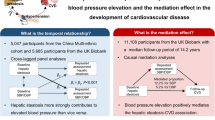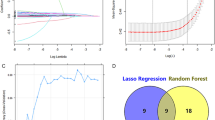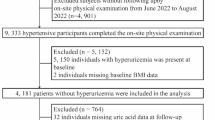Abstract
The prevalence of nonalcoholic fatty liver disease (NAFLD) has been increasing rapidly worldwide, affecting 25–30% of the population. Fatty liver index (FLI) is a validated marker of NAFLD and can be used as a screening tool for hepatic steatosis. The purpose of the study was to evaluate the relationship between FLI and the risk of major cardiovascular events in never treated hypertensive patients. We included 903 hypertensive patients without a history of cardiovascular disease (mean age 52.7 ± 11.4 years; men 55%; baseline clinic BP 149.8 ± 15.2/95.5 ± 10.1 mmHg). Participants were prospectively evaluated for a mean follow-up period of 5.2 ± 3.2 years with at least one annual visit. Patients were also categorized into two groups using an FLI of 60 units. The incidence of cardiovascular events during follow-up was 8.5% (n = 77). Patients with FLI < 60 (n = 625) had a better BP control compared to their counterparts with FLI ≥ 60 (n = 278) during follow up (43% vs 33%, p = 0.02). Cox-regression analysis indicated that FLI (Hazard Ratio [HR], 1.05; 95% Confidence Interval [CI], 1.03–1.07, p < 0.001), FLI z-scores (HR, 3.66; 95% CI, 2.22–6.04) and high-risk FLI (HR, 7.5; 95% CI, 3.12–18.04) were independent determinants of the outcome after adjustment for baseline and follow-up variables. Stratification by diabetes mellitus indicated that FLI predicted the outcome to a greater extent in those with than those without diabetes (P-interaction < 0.001). In conclusion, FLI has an independent prognostic value for the incidence of cardiovascular events in newly diagnosed, never-treated hypertensive patients. Therefore, FLI might identify higher-risk patients in the primary prevention of hypertension.
This is a preview of subscription content, access via your institution
Access options
Subscribe to this journal
Receive 12 print issues and online access
$259.00 per year
only $21.58 per issue
Buy this article
- Purchase on SpringerLink
- Instant access to full article PDF
Prices may be subject to local taxes which are calculated during checkout

Similar content being viewed by others
References
Zhang XJ, She ZG, Li H. Time to step-up the fight against NAFLD. Hepatology 2018;67:2068–71.
Zhou F, Zhou J, Wang W, Zhang XJ, Ji YX, Zhang P, et al. Unexpected rapid increase in the burden of nonalcoholic fatty liver disease in China from 2008 to 2018: a systematic review and metaanalysis. Hepatology 2019;70:1119–33.
Oikonomou D, Georgiopoulos G, Katsi V, Kourek C, Tsioufis C, Alexopoulou A, et al. Non-alcoholic fatty liver disease and hypertension: coprevalent or correlated? Eur J Gastroenterol Hepatol. 2018;30:979–85.
Bonnet F, Gastaldelli A, Pihan-Le Bars F, Natali A, Roussel R, Petrie J, et al. D.E.S.I.R., RISC Study Groups. Gamma-glutamyltransferase, fatty liver index and hepatic insulin resistance are associated with incident hypertension in two longitudinal studies. J Hypertens. 2017;35:493–500.
Huh JH, Ahn SV, Koh SB, Choi E, Kim JY, Sung KC, et al. A Prospective Study of fatty liver index and incident hypertension: the KoGES-ARIRANG Study. PLoS One. 2015;10:e0143560.
Duell PB, Welty FK, Miller M, Chait A, Hammond G, Ahmad Z, et al. American Heart Association Council on Arteriosclerosis, Thrombosis and Vascular Biology; Council on Hypertension; Council on the Kidney in Cardiovascular Disease; Council on Lifestyle and Cardiometabolic Health; and Council on Peripheral Vascular Disease. Nonalcoholic fatty liver disease and cardiovascular risk: a scientific statement from the American Heart Association. Arterioscler Thromb Vasc Biol. 2022;42:e168–e185.
Bedogni G, Bellentani S, Miglioli L, Masutti F, Passalacqua M, Castiglione A, et al. The Fatty Liver Index: a simple and accurate predictor of hepatic steatosis in the general population. BMC Gastroenterol. 2006;2:6–33.
Cai J, Zhang XJ, Ji YX, Zhang P, She ZG, Li H. Nonalcoholic fatty liver disease pandemic fuels the upsurge in cardiovascular diseases. Circ Res. 2020;126:679–704.
Williams B, Mancia G, Spiering W, Agabiti Rosei E, Azizi M, Burnier M, et al. Authors/Task Force Members:. 2018 ESC/ESH Guidelines for the management of arterial hypertension: The Task Force for the management of arterial hypertension of the European Society of Cardiology and the European Society of Hypertension: The Task Force for the management of arterial hypertension of the European Society of Cardiology and the European Society of Hypertension. J Hypertens. 2018;36:1953–2041.
O’Brien E, Parati G, Stergiou G, Asmar R, Beilin L, Bilo G, et al. European Society of Hypertension Working Group on Blood Pressure Monitoring. European Society of Hypertension position paper on ambulatory blood pressure monitoring. J Hypertens. 2013;31:1731–68.
Clase CM, Kiberd BA, Garg AX. Relationship between glomerular filtration rate and the prevalence of metabolic abnormalities: results from the Third National Health and Nutrition Examination Survey (NHANES III). Nephron Clin Pr. 2007;105:178–84.
Third report of the National Cholesterol Education Program (NCEP) expert panel on detection, evaluation, and treatment of high blood cholesterol in adults (Adult Treatment Panel III). Final report. Circulation 2002;106:3143–421.
Lloyd-Jones DM, Braun LT, Ndumele CE, Smith SC Jr, Sperling LS, Virani SM, et al. Use of risk assessment tools to guide decision making in the primary prevention of atherosclerotic cardiovascular disease: a special report from the American Heart Association and American College of Cardiology. J Am Coll Cardiol. 2019;73:3153–67.
Thomopoulos C, Antza C. Legacy effect on mortality in antihypertensive drug comparison trials: a meta-analysis. J Hypertens. 2019;37:1532–4.
Hirakawa Y, Arima H, Rodgers A, Woodward M, Chalmers J. Cumulative in-trial and posttrial effects of blood pressure and lipid lowering: systematic review and meta-analysis. J Hypertens. 2017;35:905–13.
Ipsen DH, Lykkesfeldt J, Tveden-Nyborg P. Molecular mechanisms of hepatic lipid accumulation in non-alcoholic fatty liver disease. Cell Mol Life Sci. 2018;75:3313–7.
Lan YL, Lou JC, Lyu W, Zhang B. Update on the synergistic effect of HSL and insulin in the treatment of metabolic disorders. Ther Adv Endocrinol Metab. 2019;10:2042018819877300.
Godoy-Matos AF, Silva Junior WS, Valerio CM. NAFLD as a continuum: from obesity to metabolic syndrome and diabetes. Diabetol Metab Syndr. 2020;12:60.
Siafi E, Andrikou I, Konstantinidis D, Kakouri N, Iliakis P, Koskinas J, et al. Fatty liver index and hypertension-mediated organ damage in never-treated hypertensive patients without diabetes mellitus. J Hypertens. 2021;39:2470–7.
Iwai M, Horiuchi M. Devil and angel in the renin-angiotensin system: ACE angiotensin II-AT1 receptor axis vs. ACE2-angiotensin-(1-7)-mas receptor axis. Hypertens Res. 2009;32:533–6.
Giacchetti G, Sechi LA, Rilli S, Carey RM. The renin-angiotensin aldosterone system, glucose metabolism and diabetes. Trends Endocrinol Metab. 2005;16:120–6.
Author information
Authors and Affiliations
Contributions
ES, CTh, CTs, DK, and IA, contributed to the conception or the design of the present work. ES, NK, FT, MK, CF, IZ, EM, SD, IL, and SP contributed to the data acquisition. ES, CTh, CTs, and IA, contributed to data analysis and interpretation of the results. ES and CTh, drafted the first version of the manuscript. CTh and CTs. critically revised the manuscript. All authors gave final approval and agreed to be accountable for all aspects of the work, ensuring integrity and accuracy.
Corresponding author
Ethics declarations
Conflict of interest
CTh reports honoraria for lectures or consultancy fees from Menarini, Medtronic, Berlin-Chemie, Sanofi, and AstraZeneca. CTs, reports honoraria for advisory boards and lectures from Medtronic, Servier, Bayer, Menarini, Novartis, AstraZeneca, Boehringer, Pfizer, Pythagoras, Sanofi, and Amgen. All other authors report no conflict. However, all authors have not received any funding directly related to the subject or content of this work.
Additional information
Publisher’s note Springer Nature remains neutral with regard to jurisdictional claims in published maps and institutional affiliations.
Supplementary information
Rights and permissions
Springer Nature or its licensor (e.g. a society or other partner) holds exclusive rights to this article under a publishing agreement with the author(s) or other rightsholder(s); author self-archiving of the accepted manuscript version of this article is solely governed by the terms of such publishing agreement and applicable law.
About this article
Cite this article
Siafi, E., Andrikou, I., Thomopoulos, C. et al. Fatty liver index and cardiovascular outcomes in never-treated hypertensive patients: a prospective cohort. Hypertens Res 46, 119–127 (2023). https://doi.org/10.1038/s41440-022-01015-x
Received:
Revised:
Accepted:
Published:
Issue date:
DOI: https://doi.org/10.1038/s41440-022-01015-x
Keywords
This article is cited by
-
High red meat consumption among PNPLA3 polymorphism carriers is associated with NAFLD in a multi-center cross-sectional study
European Journal of Clinical Nutrition (2024)
-
Mechanisms underlying the bidirectional association between nonalcoholic fatty liver disease and hypertension
Hypertension Research (2023)
-
Fatty liver index predicts the development of hypertension in a Japanese general population with and without dysglycemia
Hypertension Research (2023)
-
Fatty liver index has potential as a predictor of hypertension in the Japanese general population
Hypertension Research (2023)



